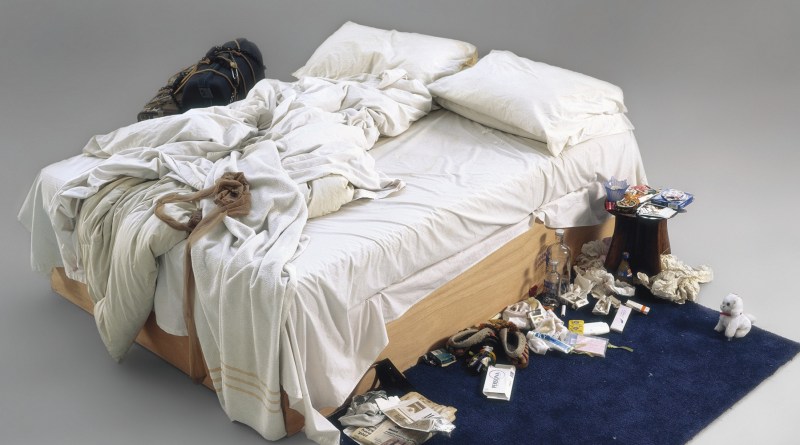Everything
All throughout art history, artists have been pushing the boundaries in the from of paintings, photography, sculptures and installations. From creating political statements, highlighting social issues to professing religious views, there have been a number of worldwide artists that have crossed the line into uncertain morality.
Following the most recent display of Dana Schuz’s “Open Cakset”, a portrayal of Emmett Till, a black 14-year-old boy who was lynched by two white men in Mississippi in 1955 and exhibited at the Whitney Biennial 2017, we have put together 10 of the most controversial artworks in recent times. From sexual connotations to animal cruelty and religious blasphemy, these artworks caused widespread outrage amongst communities.
The Physical Impossibility of Death in the Mind of Someone Living, 2017
No stranger to the odd dose of controversy, Damien Hirst captured worldwide attention with his 1991 instalment of a dead tiger shark. Preserved in a case of formaldehyde, outrage was sparked by animal rights groups who believed the practice inhumane. Many considered that the installation was not art, and that anyone could make this. His response? “But you didn’t, did you?”

Myra, 1995
A painting depicting one half of the sadistic Moors murderers, artist Marcus Harvey adapted a police mug shot of Myra Hindley onto a large scale canvas. As one of the most hated identities of the mid ’90s, it was inevitable controversy would ensue. Security guards had to watch the painting as other artists threw ink and eggs onto it. However, the exhibition was a resounding success as over 300,00 people went to see the canvas.

Guernica, 1937
One of Pablo Picasso’s most recognisable pieces, oil painting Guernica initially caused controversy due to its political statement. The main subject of Guernica was the slaughter of civilians by the Fascist government of Spain, which was allied with the Nazis. At the time, it was piece of war propaganda, used to condemn Fascism. After the WWII ended, the controversy was no longer relevant.

The Gross Clinic, 1875
Whilst Thomas Eakin’s, ‘The Gross Clinic’ doesn’t appear overly controversial, for the late 1800’s the realism oil painting proved too graphic for that age. Revealing a surgery procedure, it was revolutionary in the way people viewed medicine, and while the woman on the left seems very distressed the calmness of doctors caused viewers shock.

My Bed, 1998
Whether you consider it art or simply a hot mess, Tracey Emin’s “My Bed” was an overnight sensation. An unmade bed, soiled underwear, pantyhose, empty vodka bottles and used condoms was the subject for the installation. While many people flocked from all corners to view the artwork, art critics claimed that anyone could put an unmade bed on display, and considered it a farce. Emin later proved them wrong, selling the artwork for £150,000.

Les Demoiselles d’ Avignon, 1907
It is no surprise that another one of Pablo Picasso’s masterpieces made the list, this time with Les Demoiselles d’ Avignon. The large oil painting from 1907, was a new expression for the artist, a form of key proto-cubist work. Unveiled in 1916, the depiction of five nude prostitutes was too progressive for many viewers, even Henri Matisse calling it ‘hideous’.

The Holy Virgin Mary, 1996
While Chris Ofili won the Turner Prize for his mixed media “The Holy Virgin Mary”, it caused outrage when exhibited in New York during 1999. Depicting a black Mary, surrounded by female genitalia and a bare breast made from horse dung, art critic Rudy Guiliani called it sick and disgusting and resulted in the attempt to sue the Brooklyn Museum to have it removed. Other protesters tried to smear it with white paint horse manure.

Titled Arc, 1981
In 1979, the United States General Services Administration Art-in-Architecture program commissioned Richard Serres to create an artwork for display in Foley Federal Plaza in Manhattan. Designed and constructed in 1981, a large 36 metre long, 4 metre high solid, unfinished plate of rust-covered COR-TEN steel was placed in the middle of the plaza. Critics fought over the ugliness and use of the sculpture for eight years before it was taken down in 1989.

Piss Christ, 1987
Another work of blasphemy, Piss Christ’s Andres Serrano received death threats and injunctions in result of his 1987 work. Raised as a catholic, the artist submerged a small crucifix in a container of urine in which a print was created. While Serrano has survived his controversial work, the print has been damaged by Christian protestors.

Fountain, 1917
A clear representation of the Dadaist art movement, Marcel Duchamp‘s “Fountain” shocked its viewers. A urinal was used and inscribed with the signature “R.Mutt” and although it is now considered a philosophical statement regarding what we consider to be a work of value, the sculpture was rejected by many galleries for not being what they considered art.
